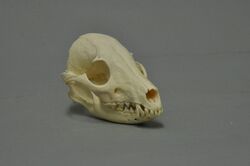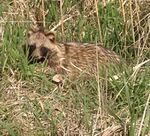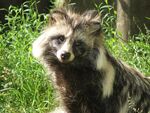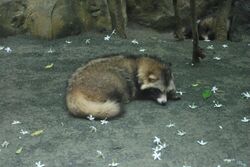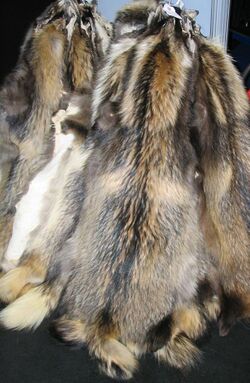Biology:Raccoon dog
| Raccoon dog | |
|---|---|
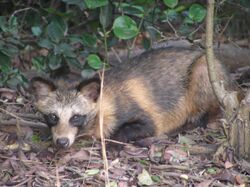
| |
| N. procyonoides viverrinus in Shiraishijima, Japan | |
| Scientific classification | |
| Domain: | Eukaryota |
| Kingdom: | Animalia |
| Phylum: | Chordata |
| Class: | Mammalia |
| Order: | Carnivora |
| Family: | Canidae |
| Genus: | Nyctereutes |
| Species: | N. procyonoides
|
| Binomial name | |
| Nyctereutes procyonoides (Gray, 1834)
| |
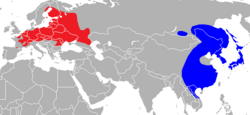
| |
| Raccoon dog range Blue – native area Red – area of introduction | |
| Raccoon dog |
|---|
The raccoon dog (Nyctereutes procyonoides), also known as the mangut (its Evenki name),[2] tanuki or neoguri, is a canid indigenous to East Asia. It is the only extant species in the genus Nyctereutes. Despite its name, its closest relatives are the true foxes, and not the American raccoons.
Among the Canidae, the raccoon dog shares the habit of regularly climbing trees only with the North American gray fox, to which it is not closely related.[3][4][5][6]
The raccoon dog is named for the resemblance of its masked face to that of the common raccoon (Procyon lotor), a procyonid to which it is not closely related. In Japan, it is known as the tanuki and has a long history in folklore. In Sweden, where it is called mårdhund ("marten dog"), and Denmark, where it is called mårhund (same meaning), it has been treated as a potentially hazardous invasive species.[7]
Description
Raccoon dog skulls greatly resemble those of South American foxes, particularly crab-eating foxes, though genetic studies reveal they are not closely related.[4] Their skulls are small, but sturdily built and moderately elongated, with narrow zygomatic arches. The projections of the skull are well-developed, the sagittal crest being particularly prominent in old animals.
Reflecting their omnivorous diets, raccoon dogs have small and weak canines and carnassials, flat molars, and relatively long intestines – (1.5–2.0 times longer than other canids). They have long torsos and short legs. Total lengths can range from 45 to 71 cm (18 to 28 in). The tail, at 12 to 18 cm (4.7 to 7.1 in) long, is short, amounting to less than a third of the animal's total length and hangs below the tarsal joints without touching the ground. The ears are short and protrude only slightly from the fur.
Weights fluctuate according to season: in March they weigh 3 kg (6.6 lb), while in August to early September males average 6.5–7 kg (14–15 lb), with some individuals attaining a maximal weight of 9–10 kg (20–22 lb).[2] Specimens from Japanese and Russian studies have been shown to be on average larger than those from Chinese studies.[8]
The winter fur is long and thick with dense underfur and coarse guard hairs measuring 120 mm in length. The winter fur protects raccoon dogs from low temperatures ranging down to −20° to −25 °C. It is of a dirty, earth-brown, or brownish-grey colour with black guard hairs. The tail is darker than the torso. A dark stripe is present on the back, which broadens on the shoulders, forming a cross shape. The abdomen is yellowish-brown, while the chest is dark brown or blackish. The muzzle is covered in short hair, which increases in length and quantity behind the eyes. The cheeks are coated with long, whiskery hairs. The summer fur is brighter and reddish straw-coloured.[2]
A rare, white color phase occurs in this species in Japan[9] and in China.[10] They can also come in a yellow color.[11]
Ecology
Diet
Raccoon dogs are omnivores that feed on insects, rodents, amphibians, birds, fish, reptiles, mollusks, carrion, and insectivores, as well as fruits, nuts, and berries.[12][13][14] Among the rodents targeted by raccoon dogs, voles seem to predominate in swampy areas, but are replaced with gerbils in flatland areas such as Astrakhan. Frogs are the most commonly taken amphibians; in the Voronezh region, they frequently eat fire-bellied toads, while European spadefoot toads are usually taken in Ukraine. Raccoon dogs are able to eat toads that have toxic skin secretions by producing copious amounts of saliva to dilute the toxins.[15] They prey on waterfowl, passerines, and migrating birds. Grouse are commonly hunted in their introduced range, and many instances of pheasant predation are recorded in the Ussuri territory.
Raccoon dogs eat beached fish and fish trapped in small water bodies. They rarely catch fish during the spawning season, but eat many during the spring thaw. In their southern range, they eat young tortoises and their eggs. Insectivorous mammals hunted by raccoon dogs include shrews and hedgehogs, and on rare occasions, moles and desmans. In the Ussuri territory, large moles are their primary source of food. Plant food is highly variable, and includes bulbs, rhizomes, oats, millets, maize, nuts, fruits, berries, grapes, melons, watermelons, pumpkins, and tomatoes.[2] In Japan, they have been observed to climb trees to forage for fruits and berries,[4][5] using their curved claws to climb.[6]
Raccoon dogs adapt their diets to the season; in late autumn and winter they feed mostly on rodents, carrion, and feces, while fruit, insects, and amphibians predominate in spring. In summer they eat fewer rodents, and mainly target nesting birds, fruits, grains, and vegetables.[2]
Predators
Wolves are the main predators of raccoon dogs, killing large numbers of them in spring and summer, though attacks have been reported in autumn too. In Tatarstan, wolf predation can account for 55.6% of raccoon dog deaths, while in northwestern Russia, it amounts to 64%. Red foxes kill raccoon dog pups, and have been known to bite adults to death.
Both foxes and Eurasian badgers compete with raccoon dogs for food, and have been known to kill them if raccoon dogs enter their burrows. Eurasian lynxes rarely attack them. Birds of prey known to take raccoon dogs include golden eagles, white-tailed eagles, goshawks, and eagle owls.[2]
Behavior
Reproduction and development
The mating season begins from early February to late April, depending on location. Raccoon dogs are monogamous animals, with pair formations usually occurring in autumn. Captive males, however, have been known to mate with four or five females. Males will fight briefly, but not fatally, for mates.[2] Copulation occurs during the night or dawn and typically will last 6–9 minutes.[16] Estrus lasts from a few hours to six days, during which females may mate up to five times. Females enter estrus again after 20–24 days, even when pregnant.
The gestation period lasts 61–70 days, with pups being born in April–May. Litter sizes typically consist of 6–8 pups, though 15–16 pups can be born in exceptional cases. First-time mothers typically give birth to fewer pups than older ones. Males take an active role in raising the pups.[2] This male role is very significant, as demonstrated by early releases in 1928 of pregnant females without males, resulting in very limited success at introduction, while later releases of pairs from 1929 until the 1960s resulted in the raccoon dog's now-extensive introduced European range.[17]
At birth, pups weigh 60–110 g, and are blind and covered in short, dense, soft wool lacking guard hairs. Their eyes open after 9–10 days, with the teeth erupting after 14–16 days. Guard hairs begin to grow after 10 days, and first appear on the hips and shoulders. After two weeks, they lighten in colour, with black tones remaining only around the eyes. Lactation lasts for 45–60 days, though pups begin eating food brought to them as early as the age of three weeks to one month. They reach their full size at the age of 4.5 months. Pups leave their parents in late August–September. By October, the pups, which by then resemble adults, unite in pairs. Sexual maturity is reached at 8–10 months. Their longevity is largely unknown; animals 6–7 years of age have been encountered in the wild, while captive specimens have been known to live for 11 years.[2]
Hibernation
Raccoon dogs are the only canids known to hibernate. In early winter, they increase their subcutaneous fat by 18–23% and their internal fat by 3–5%. Animals failing to reach these fat levels usually do not survive the winter. During their hibernation, their metabolism decreases by 25%. In areas such as Primorsky Krai and their introduced range, raccoon dogs hibernate only during severe snowstorms. In December, their physical activity decreases once snow depth reaches 15–20 cm, and limit the range from their burrows to no more than 150–200 m. Their daily activities increase during February when the females become receptive and when food is more available.[2]
Vocalizations
Like foxes, they do not bark, uttering instead a growl, followed by a long-drawn, melancholy whine. Captive specimens have been known to utter daily a very different kind of sound when hungry, described as a sort of mewing plaint.[18][failed verification] Males fighting for females may yelp and growl.[2] Japanese raccoon dogs produce sounds higher in pitch than those of domestic dogs, and sound similar to cats.[4]
Subspecies
(As of 2005),[19] five subspecies are recognised by MSW3:
| Subspecies | Trinomial authority | Description | Range | Synonyms |
|---|---|---|---|---|
| Chinese raccoon dog N. p. procyonoides Nominate subspecies |
1834, Gray | Eastern China | kalininensis (Sorokin, 1958) sinensis (Brass, 1904) stegmanni (Matschie, 1907) | |
| Korean raccoon dog N. p. koreensis |
1922, Mori | Korean peninsula | ||
| Yunnan raccoon dog N. p. orestes |
1923, Thomas | Southeastern China, northern Vietnam | ||
| Ussuri raccoon dog N. p. ussuriensis |
1907, Matschie | Distinguished from N. p. procyonides by its larger size and denser, longer hair.[2] After being introduced to western USSR, it now occurs throughout Northern, Central and Eastern Europe. | Russia (Ussuri and Amur territories), northeastern China and Korea, Europe | amurensis (Matschie, 1907) |
| Japanese raccoon dog N. p. viverrinus |
1904, Beard | A small subspecies known locally as the tanuki, it has a smaller skull and teeth as compared to those of N. p. ussuriensis,[4] it has the silkiest pelt among raccoon dogs.[20]
Some debate exists in the scientific community regarding speciation between the other subspecies of raccoon dog and the Japanese subspecies in that due to chromosomal, behavioral, and weight differences, the Japanese raccoon dog could be considered a separate species from the other subspecies.[21] Genetic analysis confirmed unique sequences of mtDNA, classifying the Japanese raccoon dog as a distinct isolation species, based on evidence of eight Robertsonian translocations. The International Union for Conservation of Nature Canid Group's Canid Biology and Conservation Conference in September 2001 rejected the classification of the Japanese raccoon dog as a separate species, but its status is still disputed, based on its elastic genome.[22] |
Japan | albus (Hornaday, 1904) |
Expanded range and invasive species
From 1928 to 1958, 10,000 raccoon dogs of the N. p. ussuriensis subspecies were introduced in 76 districts, territories, and republics of the Soviet Union in an attempt to improve their fur quality. Primor'e in the Russian Far East was the first region to be colonised, with individuals being transplanted from islands in the Sea of Japan. By 1934, raccoon dogs were introduced into Altai, the northern Caucasus, Armenia, Kirgizia, Tatarstan, Kalinin, Penza, and Orenburg regions. In the following year, they were further introduced into Leningradsky, Murmansk, Novosibirsk, and Bashkortostan.
Raccoon dogs in Irkutsk, Novosibirsk, Trans-Baikaliya, and Altai did not fare well, due to harsh winters and scarce food. Raccoon dogs also fared badly in the mountainous regions of the Caucasus, Central Asia, and Moldova. However, successful introductions occurred in the Baltic states, European Russia (particularly in Kalinin, Novgorod, Pskov, and Smolensk regions), in central Russia (Moscow, Yaroslavl, Vologda, Gorkiy, Vladimir, Ryazan Oblasts, etc.) as well as in the black soil belt (Voronezh, Tambov and Kursk), the lower Volga Region and the level parts of the northern Caucasus and Dagestan. In Ukraine, the greatest numbers of raccoon dogs were established in Poltava, Kherson, and Lugansk.[2]
In 1948, 35 raccoon dogs were introduced into Latvia. The population increased rapidly. In 1960, Latvia officially reported a total of 4,210 raccoon dogs were hunted.[23]
The raccoon dog is now abundant throughout Estonia, Finland , Latvia, and Lithuania, and has been reported as far away as Bulgaria,[24] Serbia, France , Poland , Czech Republic,[25] Belarus , Romania, Moldova, Hungary, Belgium,[26] Netherlands,[27] Luxembourg, Switzerland ,[28] Germany ,[29] Norway , Denmark , and Sweden.[7] In response, Denmark set a goal of zero breeding raccoon dogs by 2015.[30] However, by 2018 it had become fully established in Jutland (the mainland of Denmark, directly connected to Germany), with further projects mainly aimed at limiting or preventing its spread on the Danish islands.[31]
Diseases and parasites
A virus similar to SARS-CoV was isolated from Himalayan palm civets (Paguma larvata), a raccoon dog, and humans working in a live-animal market in Guangdong, China in May 2003.[32]
Raccoon dogs, as well as masked palm civets, were originally believed to be the natural reservoirs of severe acute respiratory syndrome–related coronavirus. However, genetic analysis has since convinced most experts that bats are the natural hosts.[33] Raccoon dogs were most likely only transient accidental hosts.[34]
According to Christian Drosten the raccoon dog is the most likely intermediate host for transmission of SARS-CoV-1 and SARS-Cov-2 to humans, as racoon dogs are bred in China in fur farming.[35][36][37]
Other viruses
The introduction of the raccoon dog to Europe is thought to have brought with it infected ticks that introduced the Asian tick-borne meningoencephalitis virus.[38]
Cases of raccoon dogs carrying rabies are known from the lower Volga, Voronezh, and Lithuania.[2][citation needed]
Canine distemper occurs in raccoon dogs inhabiting the northern Caucasus.[2][citation needed]
Bacteria
Captive raccoon dogs in Soviet state animal farms were recorded to carry paratyphoid, anthrax, and tuberculosis.[2][citation needed]
Eukaryotes
Apicomplexa
Massive epizootics of piroplasmosis were recorded in Ukraine and Tartary.[2][citation needed]
Worms
Raccoon dogs carry 32 different parasitic worms, including eight trematode species, 17 species of nematodes, seven cestodes, and particularly Echinococcus.[2][citation needed]
Arthropods
Ticks include Dermacentor pictus, Ixodes ricinus, I. persulcatus, I. crenulatus, and Acarus siro.[2]
Six species of fleas are known to be carried by them, including Chaetopsylla trichosa, C. globiceps, Paraceras melis, Ctenocephalides felis, C. canis and Pulex irritans.[2][citation needed]
Although they can be infected with mange, it does not pose a significant threat to their populations as it does with foxes.[2]
Relationships with humans
Game and crop damage
Raccoon dogs are harmful to game bird populations, particularly in floodlands and the shorelines of estuaries, where they feed almost exclusively on eggs and chicks during the spring period. Birds amount to 15–20% of their diets in Lithuania, 46% on the Oka River floodlands, and 48.6% in the Voronezh Reserve. They are also harmful to the muskrat trade, destroying their nests and eating their young. In Ukraine, raccoon dogs are harmful to kitchen gardens, melon cultivations, vineyards, and corn seedlings.[2]
Hunting
Raccoon dogs are typically hunted from November until the snow deepens. In the Far East, they are hunted at night using Laikas and mongrels. In the 19th century, the Goldi and Oroch people fastened bells to the collars of their raccoon dog hounds. In their introduced range, raccoon dogs are usually caught incidentally during hunts for other species. Hunting with dogs is the most efficient method in raccoon dog hunts, having success rates of 80–90%, as opposed to 8–10% with guns and 5–7% with traps. Unless they retreat in their burrows, hunted raccoon dogs can be quickly strangled by hunting dogs. Traps are usually set at their burrows, along the shores of water bodies, and around marshes and ponds.[2]
In Finland, 60,000–70,000 raccoon dogs were hunted in 2000, increasing to 170,000 in 2009 and 164,000 in 2010. Hunting of raccoon dogs in Hungary began in 1997, with an annual catch of one to nine animals. In Poland, 6,200 were shot in 2002–2003. Annual Swedish and Danish raccoon dog hunts usually result in the capture of two to seven individuals. Between 18,000 and 70,000 Japanese raccoon dogs were killed in Japan from the post-WWII period to 1982. Japan intensified its raccoon dog culling starting in the 1970s, averaging 4,529 kills annually between 1990 and 1998. The numbers killed have since decreased.[4]
Fur use
When used on clothing, the fur of the raccoon dog is often called "murmansky" or "tanuki" fur. In the United States, it is marketed as "Asiatic raccoon", and in Northern Europe as "Finn raccoon".[39] Generally, the quality of the pelt is based on the silkiness of the fur, as its physical appeal depends upon the guard hairs being erect, which is only possible in silkier furs. Small raccoon dog pelts with silky fur command higher prices than large, coarse-furred ones. Due to their long and coarse guard hairs and their woolly fur fibre, which has a tendency to felt or mat, raccoon dog pelts are used almost exclusively for fur trimmings. Japanese raccoon dog pelts, though smaller than other geographic variants, are the most valued variety, with specimens from Amur and Heilongjiang coming close behind, while Korean and southern Chinese are the least valued.[20] When raised in captivity, raccoon dogs can produce 100 g of wool of slightly lesser quality than that of goats.[2]
In the Japanese islands, the natives employed raccoon dog skin to make bellows, to decorate their drums, and for winter headgear.[18] Russian trade in raccoon dogs was quite developed in the Primorye and Ussuri areas in the 1880s. The world trade of raccoon dog pelts during 1907–1910 amounted to 260,000–300,000, of which an estimated 20,000 (5–8%) came from Russia, though more recent figures estimate a lesser number of 5,000–6,000; 12,000 raccoon dogs were caught in the 1930s. In their introduced range, licensed trade of raccoon dogs began in 1948–1950, with restrictions being removed in 1953–1955.
After the trade began, the number of catches increased sharply; from 1953–1961, it fluctuated between 30,000 and 70,000. In the latter year, about 10,000 were taken from their natural range in the Far East, while 56,000 were taken in their introduced range. Of the 56,000, 6,500 came from Belarus, 5,000 in Ukraine, 4,000 each for Latvia, Lithuania, and Krasnodar, 3,700 in Kalinin, 2,700 in Pskov, and 2,300 in Astrakhan, while 1,000–2,000 pelts each were produced in Vologod, Moscow, Leningrad, Novogrod, Smolensk, Yaroslavl, Azerbaijan, Estonia, and Dagestan. Fewer than 1,000 pelts were produced in all remaining republics and districts. Successful raccoon dog introductions in Kalinin resulted in animals with denser and softer fur: The length of guard and top hairs increased by 7.96%, that of the underfur increased by 5.3%. The thickness of the guard and top hairs decreased by 3.41%. The density of the fur increased by 11.3%. They also became darker in colour, with black-brown pelts occurring in 8% of specimens, as opposed to 3% in their homeland.[2]
Captive breeding of raccoon dogs was initiated in 1928 in the Far East, with 15 state farms keeping them in 1934. Raccoon dogs were the principal furbearers farmed during the early years of collective farms, particularly in Ukraine. By the 1940s, this practice lessened in popularity, as the raccoon dogs required almost the same types of food as silver foxes, which were more valuable.[2] An investigation by three animal protection groups into the Chinese fur trade in 2004 and part of 2005 asserts approximately 1.5 million raccoon dogs are raised for fur in China.[40] The raccoon dog comprises 11% of all animals hunted in Japan.[41] Twenty percent of domestically produced fur in Russia is from the raccoon dog.[42]
Misrepresentation as artificial fur
In several widely publicized incidents, clothing advertised and sold as having synthetic faux fur, were documented as actually containing real fur from raccoon dogs.
On 22 December 2006, MSNBC reported Macy's had pulled from its shelves and its website two styles of Sean John hooded jackets, originally advertised as featuring faux fur, after an investigation concluded garments were actually made from raccoon dog.[43] Sean Combs, the label's founder, said he had been unaware of the material, but as soon as he knew about it, he had his clothing line stop using the material.
On 24 April 2008, the Humane Society of the United States (HSUS) filed a false-advertising complaint with the US Federal Trade Commission alleging at least 20 retailers in the U.S. had been mislabeling raccoon dog fur. They assert 70% of fur garments they tested were raccoon dog, but were mislabeled as faux fur, coyote, rabbit, or other animals.[44] In December 2009 Lord & Taylor announced new regulations banning the sale of raccoon dog fur in its stores.[45]
On 19 March 2013, three U.S. retailers settled lawsuits with the U.S. government following an investigation that confirmed they had been selling raccoon dog fur, but labeling it as fake (‘faux’) fur. Neiman Marcus, DrJays.com, and Eminent (Revolve Clothing) reached settlements with the U.S. Federal Trade Commission that do not incur financial penalties unless they mislabel the fur again.[46][47]
On 19 September 2014, the HSUS announced Kohls had been selling raccoon dog fur as faux fur.[48]
Folklore
In Japanese mythology, the raccoon dog or Tanuki, is known to be a shapeshifter, along with the fox, the badger, and other animals.
References
- ↑ Kauhala, K. & Saeki, M. (2016). Nyctereutes procyonoides. The IUCN Red List of Threatened Species 2016. doi:10.2305/IUCN.UK.2016-1.RLTS.T14925A85658776.en
- ↑ Jump up to: 2.00 2.01 2.02 2.03 2.04 2.05 2.06 2.07 2.08 2.09 2.10 2.11 2.12 2.13 2.14 2.15 2.16 2.17 2.18 2.19 2.20 2.21 2.22 2.23 2.24 2.25 "Sirenia and Carnivora (Sea cows; Wolves, and Bears)". Mammals of the Soviet Union. II. USA: Science Publishers, Inc.. 1998. Part 1a. ISBN 1-886106-81-9.
- ↑ Macdonald, David W.; Sillero-Zubir, Claudio (2004-06-24), The Biology and Conservation of Wild Canids, Oxford University Press, ISBN 9780191523359, https://books.google.com/books?id=Vrgow9ERQeIC, retrieved February 16, 2016
- ↑ Jump up to: 4.0 4.1 4.2 4.3 4.4 4.5 "Raccoon Dog". Pridobljeno: IUCN/SSC Canid Specialist Group. 2004. http://www.canids.org/species/Raccoon_dog.pdf.
- ↑ Jump up to: 5.0 5.1 Ikeda, Hiroshi (August 1986). "Old, new tricks: Asia's raccoon, a venerable member of the canid family is pushing into new frontiers". Natural History 95 (8): 40, 44.
- ↑ Jump up to: 6.0 6.1 "WAZA : World Association of Zoos and Aquariums". Waza.org. http://www.waza.org/en/zoo/visit-the-zoo/dogs-and-hyenas/nyctereutes-procyonoides..
- ↑ Jump up to: 7.0 7.1 Sweden says open season on raccoon dogs. UPI.com (2009-09-04). Retrieved on 2011-01-27.
- ↑ "Mammalian Species: Nyctereutes procyonoides". Smith.edu. http://www.science.smith.edu/msi/pdf/i0076-3519-358-01-0001.pdf.
- ↑ "Rare white raccoon dog caught". Japan Times. 2013-10-18. http://www.japantimes.co.jp/news/2013/10/18/national/rare-white-raccoon-dog-caught/.
- ↑ Yan, S.Q.; Bai, C.Y.; Qi, S.M.; Li, M.L.; Si, S.; Li, Y.M.; Sun, J.H. (2015). "Cloning and association analysis of KIT and EDNRB polymorphisms with dominant white coat color in the Chinese raccoon dog (Nyctereutes procyonoides procyonoides)". Genet. Mol. Res. 14 (2): 6549–6554. doi:10.4238/2015.June.12.8. PMID 26125860.
- ↑ Han, Jae-Ik; Yang, Hyun; Jeung, Eui-Bae; Na, Ki-Jeong (2012). "Altered expression of melanocortin‐1 receptor (MC1R) in a yellow‐coloured wild raccoon dog (Nyctereutes procyonoides)". Veterinary Dermatology 23 (3): 187–e37. doi:10.1111/j.1365-3164.2012.01036.x. PMID 22385104.
- ↑ Sutor, Astrid; Kauhala, Kaarina; Ansorge, Hermann (2010). "Diet of the raccoon dog Nyctereutes procyonoides — a canid with an opportunistic foraging strategy". Acta Theriologica 55 (2): 165–176. doi:10.4098/j.at.0001-7051.035.2009.
- ↑ Kauhala, K., Kaunisto, M., & Helle, E. (1993). "Diet of the raccoon dog, Nyctereutes procyonoides, in Finland". Zeitschrift für säugetierkunde 58 (3): 129–136.
- ↑ Sasaki, H., & Kawabata, M. (1994). "Food habits of the raccoon dog Nyctereutes procyonoides viverrinus in a mountainous area of Japan". Journal of the Mammalogical Society of Japan 19 (1): 1–8. doi:10.11238/jmammsocjapan.19.1. https://www.jstage.jst.go.jp/article/jmammsocjapan/19/1/19_1_1/_article.
- ↑ Alderton, David. (1998). Foxes, Wolves, and Wild Dogs of the World, p. 119. London: Blandford. ISBN:9780816057153
- ↑ Valtonen, M. H.; Rajakoski, E. J.; Makela, J. I. (1977). "Reproductive features in the female raccoon dog (Nyctereutes procyonoides)". Reproduction 51 (2): 517–NP. doi:10.1530/jrf.0.0510517. PMID 563458. http://www.reproduction-online.org/content/51/2/517.full.pdf.
- ↑ Alderton, David (1998). Foxes, Wolves, and Wild Dogs of the World. London: Blandford. p. 121. ISBN:9780816057153
- ↑ Jump up to: 18.0 18.1 "The natural history of dogs : canidae or genus canis of authors ; including also the genera hyaena and proteles" (PDF). Edinburgh: W.H. Lizars. 1839. https://archive.org/details/naturalhistoryof139smit.
- ↑ Wozencraft, W.C. (2005). "Order Carnivora". in Wilson, D.E.; Reeder, D.M. Mammal Species of the World: A Taxonomic and Geographic Reference (3rd ed.). Johns Hopkins University Press. pp. 532–628. ISBN 978-0-8018-8221-0. OCLC 62265494. http://www.departments.bucknell.edu/biology/resources/msw3/browse.asp?id=14000818.
- ↑ Jump up to: 20.0 20.1 Bachrach, Max. (1953). Fur: a practical treatise, 3rd ed. New York: Prentice-Hall.
- ↑ Kauhala, Kaarina (1994). "The Raccoon Dog: a successful canid". Canid News 2: 37–40. http://www.canids.org/PUBLICAT/CNDNEWS2/racoondg.htm. Retrieved 2008-08-19.
- ↑ Nie, Wenhui; Jinhuan Wang; Polina Perelman; Alexander S. Graphodatsky; Fengtang Yang (November 2003). "Comparative chromosome painting defines the karyotypic relationships among the domestic dog, Chinese raccoon dog and Japanese raccoon dog". Chromosome Research 11 (8): 735–740. doi:10.1023/B:CHRO.0000005760.03266.29. PMID 14712859.
- ↑ Miervaldis Bušs, Jānis Vanags (1987). "Medību saimniecība". Latvijas Meži. Latvia.
- ↑ Doycheva, V.; Angelov, I.; Popivanov, I.; Doychinova, T.; Shalamanov, D. (2015). "Състояние и перспективи за контрола на лайшманиозата" (in bg). Български медицински журнал (Bulgarian medical journal) 9 (2): 10. http://nt-cmb.mu-sofia.bg:8080/jspui/bitstream/10861/1271/1/Doycheva_et-al_1_BMJ_2-2015.pdf. Retrieved 2018-11-14.
- ↑ Kenety, Brian (2 April 2012). "Raccoon dogs invade Czech lands". Lidovky. http://ceskapozice.lidovky.cz/tema/raccoon-dogs-invade-czech-lands.A120402_091140_pozice_62458?setver=touch.
- ↑ "Invasive species in Belgium: Nyctereutes procyonoides". Invasive Alien Species in Belgium – Belgian Biodiversity Platform. Invasive Alien Species in Belgium. 2019. https://ias.biodiversity.be/species/show/78.
- ↑ Pieters, Janene (7 October 2016). "Raccoon Dogs Spotted in Netherlands". NL Times. https://nltimes.nl/2016/10/07/raccoon-dogs-spotted-netherlands.
- ↑ Zimmermann, F. (2004). "Monitoring der Raubtiere in der Schweiz 2004". KORA Bericht. Coordinated research projects for the conservation and management of carnivores in Switzerland. http://www.kora.ch/pdf/reports/rep29.pdf.
- ↑ Drygala, F.; Stier, N.; Zoller, H.; Boegelsack, K.; Mix, H.M.; Roth, M. (2008). "Habitat use of the raccoon dog (Nyctereutes procyonoides) in north-eastern Germany". Mammalian Biology – Zeitschrift für Säugetierkunde 73 (5): 371–378. doi:10.1016/j.mambio.2007.09.005. (Title: sic, per journal website.)
- ↑ "Mårhund (Nyctereutes procyonoides) – Lille rovdyr – stor trussel" (in da). The Danish Nature Agency. http://naturstyrelsen.dk/78592.
- ↑ "Elskovsyge skadedyr klar til at invadere Fyn" (in da). TV2 Fyn. 23 February 2018. https://www.tv2fyn.dk/artikel/elskovsyge-skadedyr-klar-til-invadere-fyn.
- ↑ Guan, Y.; Zheng, B. J.; He, Y. Q.; Liu, X. L.; Zhuang, Z. X.; Cheung, C. L.; Luo, S. W.; Li, P. H. et al. (2003-10-10). "Isolation and characterization of viruses related to the SARS coronavirus from animals in southern China". Science 302 (5643): 276–278. doi:10.1126/science.1087139. PMID 12958366.
- ↑ Paules, Catherine I.; Marston, Hillary D.; Fauci, Anthony S. (January 23, 2020). "Coronavirus Infections – More than Just the Common Cold". JAMA 323 (8): 707–708. doi:10.1001/jama.2020.0757. PMID 31971553.
- ↑ Chan, P.K.; Chan, M.C. (August 5, 2013). "Tracing the SARS-coronavirus". J Thorac Dis 5 Suppl 2: S118-21. doi:10.3978/j.issn.2072-1439.2013.06.19. PMID 23977431.
- ↑ Marderhunde als Zwischenwirt? Drosten bringt neue Virusquelle ins Spiel, auf n-tv.de vom 26. April 2020
- ↑ Der Marderhund als Coronavirus-Schleuder?. Deutsche Welle
- ↑ Cherry, James D; Krogstad, Paul (2004). "SARS: The First Pandemic of the 21st Century". Pediatric Research 56 (1): 1–5. doi:10.1203/01.PDR.0000129184.87042.FC. PMID 15152053.
- ↑ [1][|permanent dead link|dead link}}]
- ↑ "Fur Types in Brief". Furcommission.com. http://www.furcommission.com/farming/mink-biology/furtypes/.
- ↑ Hsieh-Yi, Yi-Chiao, Yu Fu, Mark Rissi and Dr Barbara Maas Fun Fur? A report on the Chinese fur industry . Careforthewild.com
- ↑ "Quality of the Environment in Japan". Env.go.jp. 1995. http://www.env.go.jp/en/wpaper/1995/eae240000000040.html.
- ↑ Dronova, Natalia and Shestakov, Alexander. Trapping a Living: Conservation and Socio-Economic Aspects of the Fur Trade in the Russian Far East. TRAFFIC Europe – Russia ISBN:978 2 96005 051 6
- ↑ "Sean John jackets were made with dog fur". NBC News. 2006-12-22. http://www.nbcnews.com/id/16329355/.
- ↑ "Investigation Shows Raccoon Dog Most Misrepresented Fur in America". The Humane Society of the United States. http://www.humanesociety.org/news/press_releases/2008/03/raccoon_dog_fur_misrepresented_031908.html.
- ↑ Donnelly, Erin (2009-12-03). "Lord & Taylor Bans Raccoon Dog Fur". StyleList. http://www.stylelist.com/2009/12/03/lord-and-taylor-bans-raccoon-dog-fur.
- ↑ "Real fur, masquerading as 'faux'". Cnbc.com. 2013-03-20. https://www.cnbc.com/id/100573170.
- ↑ "A faux faux fur kerfuffle at Nieman Marcus". Marketplace.org. http://www.marketplace.org/topics/business/faux-faux-fur-kerfuffle-nieman-marcus.
- ↑ "Kohl's sells real fur as 'faux' again – The Humane Society of the United States". Humanesociety.org. https://secure.humanesociety.org/site/Advocacy?cmd=display&page=UserAction&id=6595.
Further reading
External links
- Raccoon Dog—detailed authoritative article on the website of The Canid Specialist Group (CSG) of the International Union for the Conservation of Nature (IUCN)
- A track of Raccoon dog's introduction in Europe on GPSed.com—a long way to Europe
- World Conservation Union—article on raccoon dogs
- Animal Planet—basic information, image
Wikidata ☰ Q133189 entry

